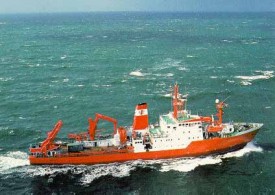|
A key element of the plate tectonics concept, the large-scale
displacement of continents, has been recognized for a long time. The puzzle
fit of the coasts on both sides of the Altantic had not escaped the notice
of early natural philosophers. Francis Bacon remarked on the parallelism
of the facing shores of the Atlantic in 1620. As early as 1858 Antonio
Snider published maps in France depicting continental drift. At the close
of the nineteenth century, the Austrian geologist Eduard Suess put some
of the pieces of the puzzle together and postulated the former existence
of a single giant continent Gondwanaland, made up of the combined present-day
southern continents. Early in this century, Alfred Wegener (Fig. 1), a
German meteorologist, cited as further evidence of continental drift the
remarkable similarity of rocks, geologic structures, and fossils on opposite
sides of the Atlantic. He postulated that a supercontinent Pangaea, once
made up of all the present continents, began to break up some 200 million
years ago, with ocean filling the widening gaps. Although the theory received
serious attention for about a decade, continental drift never caught on
except among some geologists in Europe and South Africa. A major critisism
was that no plausible driving force was available.
But today, there are several significant arguments, accepted
as good evidence of drift. The evolution of vertebrates and land plants
showed similarities in development on different continents up to the supposed
breakup time. Thereafter these organisms have shown divergent evolutionary
paths. The distribution of Permian glacial deposits in South America,
Africa, India, and Australia was difficult to explain in terms of separate
glaciers, some nowadays close to the equator. If the southern continents
are reassembled into Gondwanaland in the South-Polar region, a single
continental glacier could account for all the Permian glacial deposits.
In 1928, Arthur Holmes invoked the mechanism of thermal
convection in the mantle as the driving force. Later, convincing evidence
began to emerge as a result of extensive exploration of the sea floor
during the years following World War II. In the early 1960s Harry Hess
of Princeton University suggested that sea floors separate along the rifts
in mid-ocean ridges and that new sea floor forms by upwelling of mantle
materials in theses cracks, followed by lateral spreading. Thus was born
the theory of sea-floor spreading.
It remained for the next generation of geophysicists to
broaden the concept of continental drift and sea-floor spreading into
the more general theory of plate tectonics. Beginning about 1967, geophysisists
extended the idea of the mobility of the lithosphere by identifying the
separate lithospheric plates and discussing their relative motions and
the phenomena that occur at their boundaries. By the end of the 1960s
the evidence became so persuasive that most Earth scientists have embraced
these concepts.
|
 |
|
1 - Alfred Wegener, the pioneer of plate tectonics
|
 |
| 2 - Research vessel
FS Sonne (© Alfred-Wegener Institute, Bremen)
|
|


